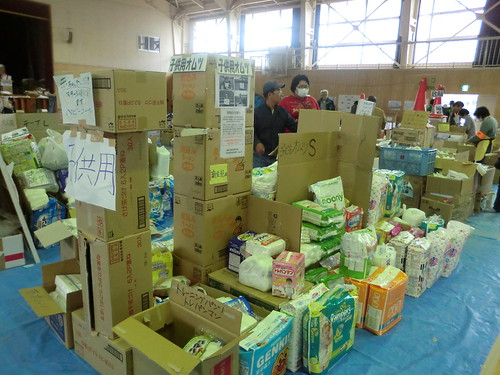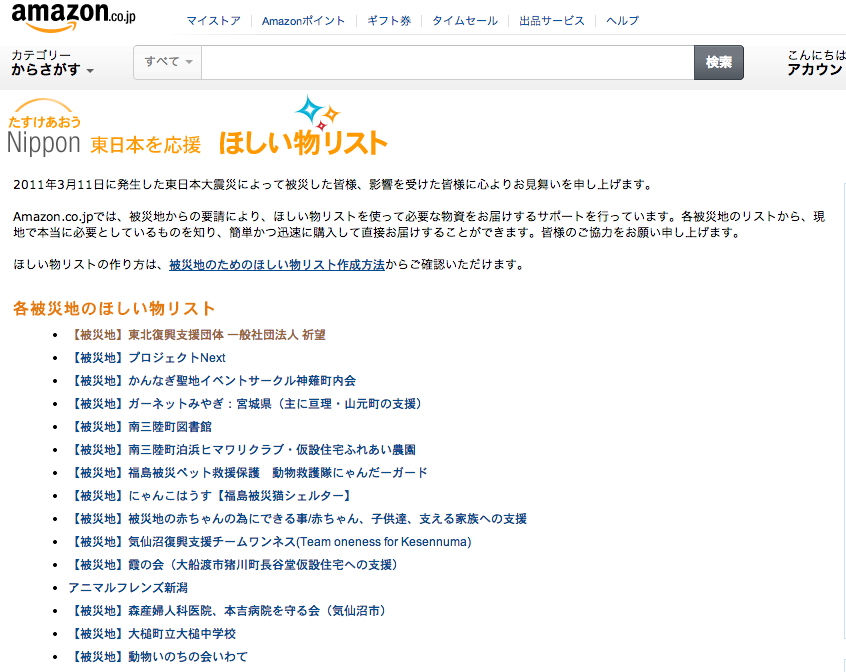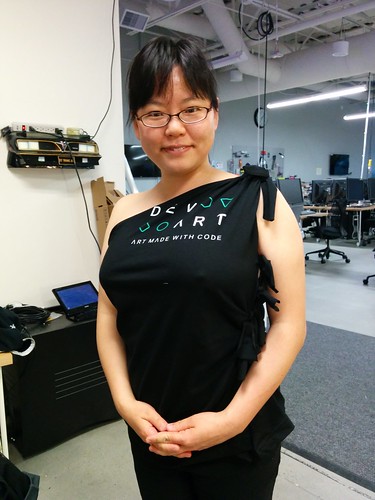Matching supplies is hard in a chaotic situation during and after natural disaster.
Power of the Internet was realized during crisis response in Japan, but there were many lessons learned there too. Many people tweeted what they needed, and supplies were sent to them, but controlling the supply and demand was difficult so some towns received 10 years worth of diapers that they could not store. Many people started to use Amazon Wishlist which worked well.
There were locals who were setting up websites to clarify what they want people to send - such as food, diapers, etc. There was a
wiki that gathered best practices to send supplies to areas hit by disaster, as well as list of the places that are accepting supply donations.
What many people don't realize is that sending supplies should be carefully done, and receiving supplies and distributing them require expertise, otherwise it will be a nightmare. We have seen several examples of those incidents.
So let's observe the problems that happened:
Too much supplies that cities are unable to cope with and piled up.
I went to one of the city halls of a bigger city, and they said they were receiving many supplies that is piling up in the storage, they are working on trying to distribute those supplies to evacuation centers restlessly, but are not able to keep up with the massive supplies.
Volunteer centers that effectively distributed supplies.
In July 2011, I went to host a hackathon in a volunteer center in Toono called
Toono Magokoro Net which was gathering many volunteers nationwide and sending them off to disaster-hit areas every day. While I was having a meeting with the director there- Mr. Kazuhiko Tada, one of the city officials from the disaster came and asked if they are able to distribute 4,000 sausages. "The sausages are going to go bad soon, but we can't distribute so many. If we ship them here, will you be able to distribute them?" Toono Magokoro Net sends off shuttles volunteers to evacuation centers everyday, and there are much more than 4,000 evacuees in those centers. "Of course. Please send it to us." replied Tada-san.

 Using Twitter effectively
Using Twitter effectively
In Japan, Twitter was amass with information about how to help people in Tohoku. Some people tweeted what they needed, and asking to send them. The problem is, when they tweet, they get too much supplies since information is uncontrollable. "Please stop sending diapers- we have received 10 years worth of diapers already"- power of Twitter was actually too strong.
Tada-san was not tech-savvy, but he was clever. He was observing the situation. "Getting local governments control supply and demand will not work, because right after the disaster, speed is important. Governments' process is slow. If you need something during disaster, you need it immediately, and getting them quickly is more important than controlling them." says Tada-san.
What he learned was that Information flow on internet is extremely speedy. Therefore, he does not tweet until the very last minute until supply is gone. If you worry that you might not have enough and tweet too early or ask for too many, you will not have places to store everything. If you tweet just before supplies are all gone, there will be massive supply arriving that is beyond what they can use. Then, he will provide those excessive supplies to neighboring towns and cities so that he can control afterwards.
Too much bureaucracy and "fairness"
One of the problems that we saw after 2011 earthquake was trying to push too much bureaucracy and fairness. "We have 100 evacuees, so we can't accept 80 rice balls because it will cause unfairness." Seriously? Just give 80 rice balls to 80 of them and give the other 20 sandwiches. But this was reality. Under the word "fairness" lots of supplies were not accepted.
Efficiency over Fairness, and trust the people
In April 2011, I visited Aizu in Fukushima, and met Mr. Tadashi Egawa who works for the city of Aizu. This is the supply center that he created which really amazed me.

Right after the earthquake, he knew there will be massive evacuation, and he knew there would be massive supplies that he would have to distribute. First thing he did was to go and get the red cones. He used the empty gymnasium to build supply center, and divided areas with the huge cones so that people will be able to know where the cleaning materials are, kitchenware are, clothes are for women, men, girls and boys etc in clusters.
Evacuees can visit this supply center and take only what they actually need. Some people take a bit more, some people takes a bit less, they did not limit the number of things they can take, but they did have people at the door to ensure visitors are behaving in a good manner. Nobody was acting evil and were taking only what they needed.
This is the "big red cone".

"Children's area" with lots of diapers.

Using Amazon Wishlist
In order to avoid un-necessary supplies coming in and eating the storage, and necessary things not coming in, many people started to use Amazon Wishlist to match what they want in the disaster-hit area and what other people can send to them.
This is the list of disaster relief for Tohoku Amazon Wishlist.
http://www.amazon.co.jp/gp/feature.html?docId=3077074166
And this is how it looks like. The evacuation center in Ogachi district and evacuees in the neighboring area are requesting 70 toilet paper rolls (of which 33 received), and 256 bags of rice (of which 218 received).
Similar project happened when Hurricane Sandy hit New York.
Occupy Sandy Hacks Amazon's Wedding Registry (in a Good Way)
This is their Amazon Wedding Registry page:
http://www.amazon.com/registry/wedding/32TAA123PJR42
You can see they are gathering supplies in masses, and they are going to be distributing them. Asked for 850 hand warmers (of which 717 received), asked for 200 safety goggles (of which 157 received), asked for 850 cleaning cloths (of which 841 received).
Medical supplies matching commander volunteering remotely from Australia
Lastly, I'd like to give an answer to the question whether you have to be in the same country or on the grounds to help. The answer is a no.
In the article "
Internet Enabled Remote Volunteer Activities(ja)" that my friends
+Nobuyuki Hayashi and
+Tatsuya Yamaji put together, they introduce one great example of Wilson Naomi. Wilson-san who was a nurse in Australia when the earthquake happened. She started to gather information as well as donation, and realized that nutritional supplements were lacking. Specifically, "Ensure" which is necessary to send nutrition by tube to patients who cannot eat by themselves, is necessary and lack of it would risk peoples' lives. To be honest, Wilson-san was not tech savvy- didn't use anything like blogs, Twitter nor Facebook before the earthquake, and in the past 3 years exchanged only 200 e-mails total. But she started what she can do- she started sending emails to ask for help, and raised 1 million yen in 2 weeks to purchase Ensure and sent them to Tohoku.
She was then asked to help a supply-matching site on delivering equipments to hospitals in Tohoku such as medical equipments, medicine, medical beds and desks and chairs etc.
When dealing with supplies in disaster struck areas, it is not true that the more supplies you get is better. What is important is matching the supplies to those who need them. In this case, medical knowledge and experience was necessary in understanding the local needs and delivering exactly what they need, and Wilson-san started to take the role as commander.
She did not use special tools for this- basically it was emails, mailing lists, blogs and Twitter. She asked via email of the needs, and used Google Maps to specify where the place in need was, where the supplier was, where the volunteer staffs were, and coordinated the delivery. She exchanged more than 10,000 emails during March to December 2011 while she was in control of the medical supply deliveries.
Lessons learned:
It is not the technology or tools that helps, it is the people that helps. Coordinator with the right knowledge is key. If we have the right technology and tools, those people will be able to connect and help beyond physical constraints such as time and location. Wilson-san's work as volunteer staff from Australia using her spare time as "commander of medical equipments deliver in Tohoku" was a great evidence of that.
Disclaimer: The opinions expressed here are my own, and do not reflect those of my employer. -
Fumi Yamazaki






























